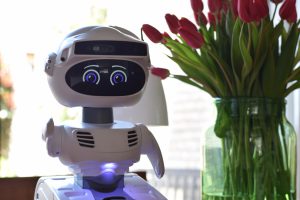Jessica Rochat is a specialist in human-machine interaction and works at Geneva University Hospitals (HUG). The Radio Télévision Suisse (RTS) interviewed her on August 18, 2020. Jessica: ‘It’s still not common for people to interact with a robot. That’s why it’s very important that we assess the needs of the end users: older people living at home.’
Jessica Rochat is also a Ph.D student in psychology and head of the EvaLab team, at the Medical Information Sciences Division of HUG. The EvaLab team focuses on conception, design and evaluation of health technology. Jessica: ‘As one of the European partners, we are participating in the innovative Guardian project because there is still a lot of research to conduct regarding the likeability of robot-based solutions. This likeability is a key factor in whether the end user will accept a robot or not.’
Learn more about Guardian
The aim of Guardian is to develop an advanced robot that supports older people living at home, community nurses and informal carers. Want to learn more about Guardian? Read the article ‘Eyes and ears of Guardian care robot’ (https://guardian-aal.eu/eyes-and-ears-of-guardian-care-robot/).
Or watch the broadcast (in French) on RTS – August 18, 2020: https://www.rts.ch/play/tv/forum-video/video/forum-des-idees-misty-le-robot-social-des-hug?urn=urn:rts:video:11540744.

Feeling less lonely
HUG has already conducted some interviews with end users. Jessica: ‘End users shared that in order to feel less lonely, they would like to have a physical presence around. A robot could meet this need when it is able to speak and interact with them.’
A friendly robot with big eyes
In her interview on RTS, Jessica shared certain features that are important for the likeability factor. Jessica: ‘We have chosen to develop the robot model Misty, which has a rather friendly shape with big eyes. These eyes have multiple options to express certain feelings. For example, the robot is able to look cheerful or show contentment when the older person has managed to do something.’
Proposing social activities and support
The robot could also fulfil other needs. Jessica: ‘Older people would like it if the robot is able to propose some activities, such as a game or physical exercise. It would also be nice if the robot is able to support with conveying information. For instance, when someone is suffering from diabetes and must follow a diet, the robot can provide support by sharing some recipes they like or by reminding them to take their medication. Or with information transmission between the senior and their informal caregiver, such as sharing a summary of a consultation the senior had with a healthcare professional.’
They don’t want the robot to replace real human contact
Jessica: ‘We have also met some challenges. End users are afraid that the robot will be too complicated to use. So, the interaction with the robot needs to be as simple as possible. Also, they don’t want the robot to be deployed as a replacement for real human contact and tasks that the professional caregiver normally provides. A solution could be that the robot motivates human contact by proposing social activities.’ HUG will continue their research in the coming period. ‘After conducting the usability tests, we will also test the robot in the homes of older people.’

